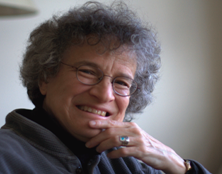- 1610: Galileo
- 1676: Ole Rømer
- 1687: Isaac Newton
- 1781: William Herschel
- 1838: Friedrich Bessel
- 1861: William and Margaret Huggins
- 1912: Henrietta Leavitt
- 1917 Einstein
- 1920: Harlow Shapley
- 1929 Edwin Hubble
- 1948: Ralph Alpher
- 1949: Fred Hoyle
- 1963: Maarten Schmidt
- 1964: Arno Penzias and Robert Wilson
- 1978: Vera Rubin and Kent Ford
- 1989: Margaret Geller and John Huchra
- 1992: John Mather and George Smoot
- 1995: Robert Williams
- 1998: Saul Perlmutter and Brian Schmidt
- 2010: Wendy Freedman
1989: Margaret Geller and John Huchra Map the Universe
 |
| Image of Margaret Geller courtesy of Massimo Ramella. |
Once Edwin Hubble showed that the Milky Way was not the only galaxy, astronomers began to take finer and finer images of distant galaxies, and it soon became evident that galaxies came in clusters. Our own cluster, called the “Local Group” has about 20 galaxies. Some clusters have more than 1,000 galaxies. But are there clusters of clusters of galaxies?
Uncovering the large-scale structure of galaxies in the universe required not only looking at images, but finding the distance to each galaxy, in order to create a three-dimensional map, showing how galaxies are distributed in the universe. John Huchra and Margaret Geller of the Harvard-Smithsionian Center for astrophysics became the leaders in this effort.
The modern version of Geller and Huchra's original map is being undertaken by the Sloan Digital Sky Survey.